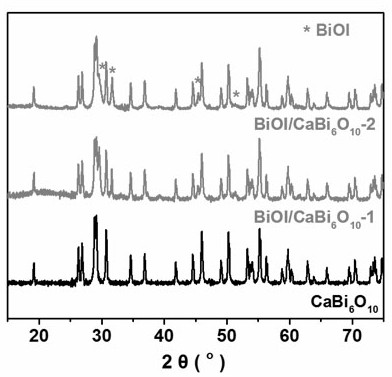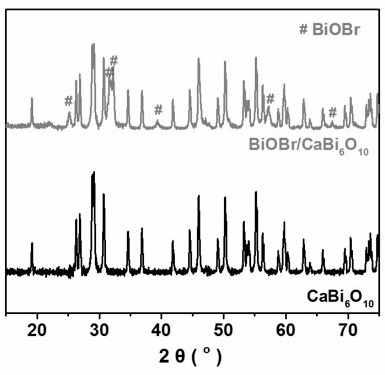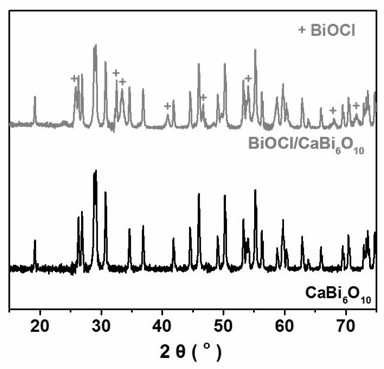Bismuth oxyhalide/calcium bismuthate composite material based on fto surface, preparation method and application of dyes in photocatalytic degradation of water
A composite material, bismuth oxyhalide technology, applied in catalyst activation/preparation, chemical instruments and methods, physical/chemical process catalysts, etc., can solve the problem of low separation rate of photogenerated carriers, poor photochemical conversion efficiency, limited applications, etc. problem, to achieve good application prospects, excellent visible light catalytic pollutant degradation performance and structural stability.
- Summary
- Abstract
- Description
- Claims
- Application Information
AI Technical Summary
Problems solved by technology
Method used
Image
Examples
Embodiment 1
[0030] A BiOX / CaBi 6 o 10 (X=1) the preparation method of composite material, it may further comprise the steps:
[0031] 1) Pretreatment of FTO conductive glass: Soak 2×2 cm FTO conductive glass (square resistance <8Ω) in ethanol and deionized water respectively, after ultrasonic cleaning for 30 minutes, blow dry with nitrogen, and place it under a 150W long-arc mercury lamp After irradiating for 180 min, take it out for use;
[0032] 2) CaBi 6 o 10 Material: Weigh 8.9g Bi(NO 3 ) 3 ·5H 2 O, 0.6g Ca(NO 3 ) 2 , 1.0g diethylenetriaminepentaacetic acid (DTPA), 0.3g ethylenediaminetetraacetic acid (EDTA) were added to 35mL HNO 3 solution (0.1 mol / L), stirred for 1 hour to fully dissolve it, and obtained solution A. Take 20 microliters of solution A and drop it on the surface of the FTO conductive glass obtained in step 1), and spin coat it evenly at a speed of 800rpm for 20s through a homogenizer, and then add 20 microliters of 0.2 mol / L ammonia water for 20s at a speed ...
Embodiment 2
[0035] A BiOX / CaBi 6 o 10 (X=1) the preparation method of composite material, it may further comprise the steps:
[0036] 1) With reference to steps 1-2 of Example 1, CaBi was obtained 6 o 10 Material;
[0037] 2) Referring to step 3) of Example 1, the concentration of KI solution in the reactor was 25mmol / L to obtain BiOX / CaBi 6 o 10 (X=I) composite material, denoted as BiOI / CaBi 6 o 10 -2.
Embodiment 3
[0039] A BiOX / CaBi 6 o 10 (X=Br) the preparation method of composite material, it comprises the steps:
[0040] 1) Pretreatment of FTO conductive glass: Soak 2×2 cm FTO conductive glass (square resistance <8Ω) in ethanol and deionized water respectively, after ultrasonic cleaning for 30 minutes, blow dry with nitrogen, and place it under a 150W long-arc mercury lamp After irradiating for 180 min, take it out for use;
[0041] 2) CaBi 6 o 10 Material: Weigh 8.9g Bi(NO 3 ) 3 ·5H 2 O, 0.6g Ca(NO 3 ) 2 , 1.0g diethylenetriaminepentaacetic acid (DTPA), 0.3g ethylenediaminetetraacetic acid (EDTA) were added to 35mL HNO 3 solution (0.1 mol / L), stirred for 1 hour to fully dissolve it, and obtained solution A. Take 20 microliters of solution A and add it dropwise on the surface of the FTO conductive glass obtained in step 1), and spin coat it evenly at a speed of 800rpm for 20s through a homogenizer, then add 20 microliters of 0.2 mol / L ammonia water dropwise at a speed of 80...
PUM
 Login to View More
Login to View More Abstract
Description
Claims
Application Information
 Login to View More
Login to View More - R&D
- Intellectual Property
- Life Sciences
- Materials
- Tech Scout
- Unparalleled Data Quality
- Higher Quality Content
- 60% Fewer Hallucinations
Browse by: Latest US Patents, China's latest patents, Technical Efficacy Thesaurus, Application Domain, Technology Topic, Popular Technical Reports.
© 2025 PatSnap. All rights reserved.Legal|Privacy policy|Modern Slavery Act Transparency Statement|Sitemap|About US| Contact US: help@patsnap.com



